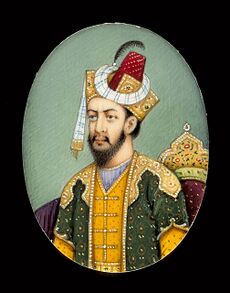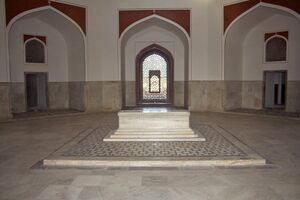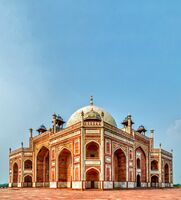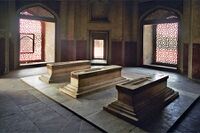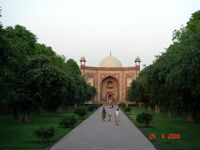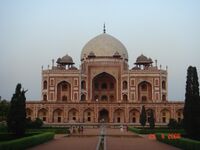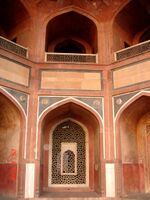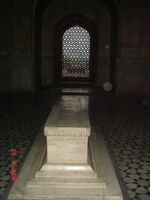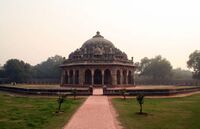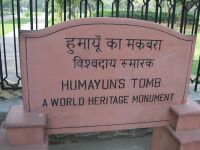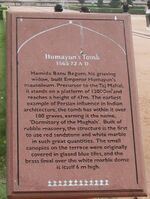مقبرة همايون
| مقبرة همايون | |
|---|---|
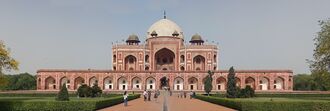 | |
 | |
| معلومات عامة | |
| النوع | Tomb |
| النمط المعماري | المغل |
| الموقع | Mathura road, شرق نظام الدين، دلهي، الهند |
| الإحداثيات | 28°35′35.8″N 77°15′02.5″E / 28.593278°N 77.250694°E |
| Design and construction | |
| المعماري | ميراك مرزا غياث وابنه، سيد محمد |
| موقع تراث عالمي لليونسكو | |
| Official name | Humayun's Tomb, Delhi |
| السمات | ثقافي: (ii), (iv) |
| مراجع | 232bis |
| التدوين | 1993 (17 Session) |
| الامتدادات | 2016 |
| المساحة | 27.04 ha (0.1044 sq mi) |
| منطقة عازلة | 53.21 ha (0.2054 sq mi) |
مقبرة همايون (بالهندوستاني: مقبرة همايون)، هي مجمع من الأبنية على طراز العمارة المغولية بني كمقبرة للإمبراطور المغولي همايون. وتقع في شرق نظام الدين، دلهي. المقبرة أمرت ببنائها الزوجة الأولى وقرينة همايون، الامبراطورة بگا بگم (وتُعرف أيضاً بإسم حاجي بگم)،[1][2][3][4][5][6][7] في 1558، وصممها ميراك مرزا غياث وابنه، سيد محمد،[8] وقد اختارت معماريين فرس.[9][10] وكانت أول حديقة-مقبرة في شبه القارة الهندية،[11] وتقع في شرق نظام الدين، دلهي، الهند، بالقرب من قلعة دينا-پانة، التي تُعرف أيضاً بإسم پرانا قلعة (القلعة القديمة)، التي أسسها همايون في 1533. كما كانت أول منشأ يستخدم الحجر الرملي الأحمر بهذا الحجم.[12][13] المقبرة أُعلِنت موقع تراث عالمي لليونسكو في 1993،[11] ومنذ ذلك الحين خضع لعمل ترميمي واسع، اكتمل.[14] بجانب مقصورة المقبرة الرئيسية لهمايون، تتناثر العديد من المعالم الأصغر في السبيل المؤدي إليها، من المدخل الرئيسي في الغرب، الذي يضم قبراً يسبق المقبرة الرئيسية نفسها، بنحو عشرين عاماً؛ إنها مجمع مقابر عيسى خان نيازي، النبيل الأفغاني في بلاط شر شاه سوري من أسرة سوري، الذي قاتل ضد المغل، وقد شـُيـِّد في 1547.
The complex encompasses the main tomb of the Emperor Humayun, which houses the graves of Empress Bega Begum, Hamida Begum, and also Dara Shikoh, great-great-grandson of Humayun and son of the later Emperor Shah Jahan, as well as numerous other subsequent Mughals, including Emperor Jahandar Shah, Farrukhsiyar, Rafi Ul-Darjat, Rafi Ud-Daulat, Muhammad Kam Bakhsh and Alamgir II.[15][16] It represented a leap in Mughal architecture, and together with its accomplished Charbagh garden, typical of Persian gardens, but never seen before in India, it set a precedent for subsequent Mughal architecture. It is seen as a clear departure from the fairly modest mausoleum of his father, the first Mughal Emperor, Babur, called Bagh-e Babur (Gardens of Babur) in Kabul (Afghanistan). Though the latter was the first Emperor to start the tradition of being buried in a paradise garden.[17][18] Modelled on Gur-e Amir, the tomb of his ancestor and Asia's conqueror Timur in Samarkand, it created a precedent for future Mughal architecture of royal mausolea, which reached its zenith with the Taj Mahal, at Agra.[19][20][21]
The site was chosen on the banks of Yamuna river, due to its proximity to Nizamuddin Dargah, the mausoleum of the celebrated Sufi saint of Delhi, Nizamuddin Auliya, who was much revered by the rulers of Delhi, and whose residence, Chilla Nizamuddin Auliya lies just north-east of the tomb. In later Mughal history, the last Mughal Emperor, Bahadur Shah Zafar took refuge here, during the Indian Rebellion of 1857, along with three princes, and was captured by Captain Hodson before being exiled to Rangoon.[10][22] At the time of the Slave Dynasty this land was under the 'KiloKheri Fort' which was capital of Sultan Kequbad, son of Nasiruddin (1268–1287).
The Tombs of Battashewala Complex lie in the buffer zone of the World Heritage Site of the Humayun Tomb Complex; the two complexes are separated by a small road but enclosed within their own separate compound wall
.[23]
. . . . . . . . . . . . . . . . . . . . . . . . . . . . . . . . . . . . . . . . . . . . . . . . . . . . . . . . . . . . . . . . . . . . . . . . . . . . . . . . . . . . . . . . . . . . . . . . . . . . . . . . . . . . . . . . . . . . . . . . . . . . . . . . . . . . . . . . . . . . . . . . . . . . . . . . . . . . . . . . . . . . . . . .
التاريخ

بعد وفاته في 27 يناير 1556،ووري جثمان همايون الثرى في قصره في پرانا قلعة في دلهي. بعد ذلك أُخِذ إلى سرهند، في الپنجاب على يد خنجر بگ، وفي 1558، تفقـَّد ابن همايون والذي صار سلطان المغل، أكبر، العمل في المقبرة الجديدة. ثم عاود أكبر زيارة المقبرة في 1571، حين قاربت على الاكتمال.[24][25][26]
The tomb of Humayun was built by the orders of his first wife and chief consort, Empress Bega Begum (also known as Haji Begum). Construction began in 1565 and was completed in 1572; it cost 1.5 million rupees,[10] paid entirely by the Empress.[27] Bega Begum had been so grieved over her husband's death that she had thenceforth dedicated her life to a sole purpose: the construction of a memorial to him than would be the most magnificent mausoleum in the Empire, at a site near the Yamuna River in Delhi.[2] According to Ain-i-Akbari, a 16th-century detailed document written during the reign of Akbar, Bega Begum supervised the construction of the tomb after returning from Mecca and undertaking the Hajj pilgrimage.[28]
العمارة
معرض الصور
Cenotaphs of Hamida Banu Begum, Dara Shikoh etc. in a side room
English garden-style roundabouts replaced the square central tanks of the Charbagh garden in 1860
انظر أيضاً
- Sunder Nursery
- Sabz Burj
- Aga Khan Historic Cities Support Programme
- Tomb of Safdarjung
- Persian Inscriptions on Indian Monuments
المصادر
- ^ Annemarie Schimmel; Burzine K. Waghmar (2004). The Empire of the Great Mughals: History, Art and Culture. Reaktion Books. pp. 149.
- ^ أ ب Kamiya, Takeo. "Humayun's Tomb in Delhi". UNESCO. Retrieved 27 January 2017.
In 1565 the previous queen of the Mughal Dynasty, Haji Begum, ordered the construction of the largest and the most splendid mausoleum in the empire for her late ill-fated husband, Humayun، بالقرب من نهر يامونة.
- ^ Burke, S. M. (1989). Akbar, the Greatest Mogul. Munshiram Manoharlal Publishers. p. 191.
- ^ Eraly, Abraham (2007). The Mughal world : Life in India's Last Golden Age. Penguin Books. p. 369. ISBN 978-0143102625.
- ^ Smith, Vincent Arthur (1919). Akbar: The Great Mogul 1542–1605. Clarendon Press. p. 125.
- ^ Henderson, Carol E. (2002). Culture and Customs of India. Greenwood Press. p. 90. ISBN 978-0313305139.
- ^ "Mausoleum that Humayun never built". The Hindu. April 28, 2003. Retrieved 31 January 2013.
- ^ "Humayun's Tomb". ArchNet. Retrieved April 23, 2018.
- ^ خطأ استشهاد: وسم
<ref>غير صحيح؛ لا نص تم توفيره للمراجع المسماةCherry - ^ أ ب ت Humayun's Tomb Archived 10 أبريل 2009 at the Wayback Machine Archaeological Survey of India.
- ^ أ ب Humayun's Tomb, Delhi لجنة التراث العالمي، اليونسكو.
- ^ Humayun's Tomb Govt. of India Portal.
- ^ Plaque at Humayun's Tomb Site.
- ^ "Facelift for Humayun". The Indian Express. 19 September 2013. Retrieved 23 September 2013.
- ^ خطأ استشهاد: وسم
<ref>غير صحيح؛ لا نص تم توفيره للمراجع المسماةdel - ^ Mausoleum of Humayun, Delhi British Library.
- ^ خطأ استشهاد: وسم
<ref>غير صحيح؛ لا نص تم توفيره للمراجع المسماةgar - ^ Humayun's Tomb and gateway British Library.
- ^ Humayun's Tomb Archived 17 أبريل 2010 at the Wayback Machine archnet.org.
- ^ Humayun's Tomb Frommer's India, by Pippa De Bruyn, Keith Bain, Niloufer Venkatraman, Shonar Joshi. Published by Frommer's, 2008. ISBN 0-470-16908-7. p. 316.
- ^ The Monuments at Delhi World Heritage Monuments and Related Edifices in India, by Ali Javid, Tabassum Javeed. Algora Publishing, 2008. ISBN 0-87586-482-1. pp. 105–106.
- ^ "The Ex-king of Delhi – Question. (Hansard, 11 December 1857)". hansard.millbanksystems.com.
- ^ "Batashewala Complex Conservation". Archnet. Retrieved 15 June 2015.
- ^ Humayun's Tomb Muqarnas: An Annual on Islamic Art and Architecture, by Oleg Grabar. Published by Brill Publishers, 1988. ISBN 90-04-08155-0. pp. 133–140.
- ^ Humayun's Tomb The New Cambridge History of India, by Geraldine Forbes, Gordon Johnson, B. R. Tomlinson. Cambridge University Press, 1988. ISBN 0-521-26728-5. pp. 45–47.
- ^ Humayun's Tomb Speaking stones: world cultural heritage sites in India, by Bill Aitken. Dept. of Tourism. Published by Eicher Goodearth Limitedjsbbfjipppnshthe house, 2001. ISBN 81-87780-00-2. pp. 45–47.
- ^ Aziz, K. K. (2004). The Meaning of Islamic Art : Explorations in Religious Symbolism and Social Relevance. Adam Publishers & Distributors. p. 510. ISBN 978-8174353979.
- ^ Haji Begum Archived 2 أغسطس 2010 at the Wayback Machine Ain-i-Akbari. "He (Qa´sim 'Ali´ Khan) was employed to settle the affairs of Hájí Begum, daughter of the brother of Humáyún's mother (tagháí zádah i wálidah i Jannat-ástání), who after her return from Makkah had been put in charge of Humáyún's tomb in Dihlí, where she died."
- Zohreh Bozorg-nia, Mimaran-i Iran. ISBN 964-7483-39-2, 2004, p.184.
انظر أيضا
وصلات خارجية
- Pictures of the Humayun’s Tomb
- Compilation of Indian Heritage Sites
- Satellite picture by Google Maps
- AKTC revitalisation of the Humayun’s Tomb Gardens
- Humayun's Tomb on Delhi-Tourism-India.com
- Pictures of Humayun's Tomb From a backpackers trip around India in 2005.
- Panoramic view on Humayun's Tomb at WHTour
- مقبرة همايون travel guide from Wikitravel
- Photos linked to Google Earth
- - photographs of Humayun's tomb and other sites in Delhi
- Pages using gadget WikiMiniAtlas
- Short description is different from Wikidata
- Coordinates on Wikidata
- Pages with empty portal template
- Buildings and structures completed in 1572
- مواقع التراث العالمي في الهند
- Mughal funerary gardens in India
- عمارة إسلامية
- Sandstone buildings in India
- Tourist attractions in Delhi
- Mausoleums in Delhi
- Aga Khan Trust for Culture projects
- Landscape design history
- Persian gardens in India
- Monuments and memorials in Delhi
- Akbar
- 1572 establishments in India
- 1572 establishments in the Mughal Empire
- Tombs in India
- عمارة مغولية
- مبانئ ومنشئات في دلهي
- مزارات سياحية في دلهي
- مقامات في الهند
- مشاريع مؤسسة أغاخان للثقافة
- صفحات مع الخرائط

